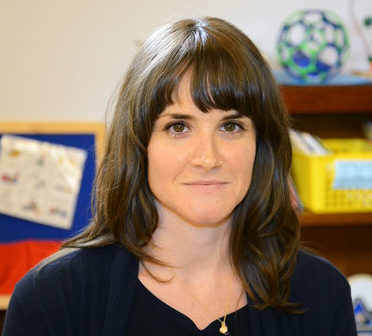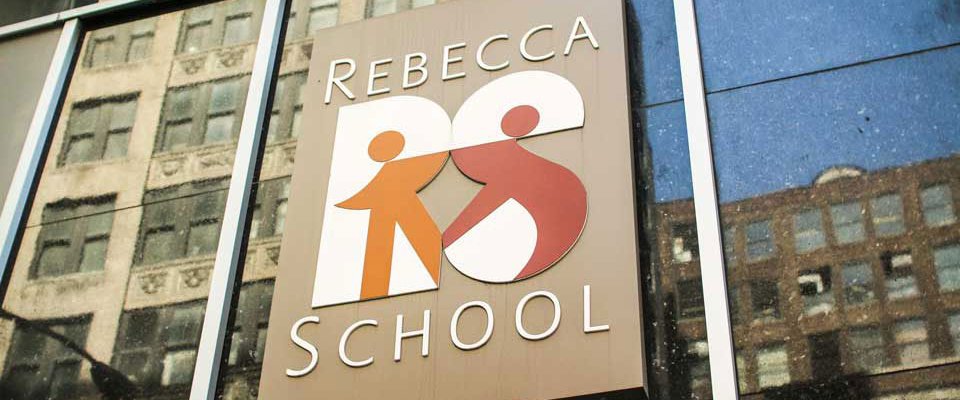This week we bring you another podcast! With our focus on schools that incorporate the Developmental, Individual differences, Relationship-based (DIR) model, we spoke with the Educational Supervisor of the Rebecca School, Rae Leeper, who has worked at the School since it opened in 2006.
The Rebecca School came together when a DIR veteran, Tina McCourt hired Dr. Gil Tippy and consulted with Dr. Stanley Greenspan to figure out what DIR would look like in a school setting. The name ‘Rebecca’ was the name of the grandmother of one of the school’s investors. The school serves 138 students, age 3 to 21 in the heart of Manhattan.
Most of their students take a bus to school, which is a vertical campus. Students take the stairs and the elevator from floor-to-floor. The top floor is a rooftop playground with high fencing.
The Rebecca School in Manhattan
Classrooms at the Rebecca School
Students at the school are assigned to classrooms with mixed groupings of 7 to 10 children, roughly grouped by age. The mixed groupings allow children to have the opportunity to be a leader and a follower, depending on their skill set so they can learn as they are pushed to communicate in different ways.
They take care to make sure all students have another child in the classroom they can be friends with, and they take care to make sure that if there are female students, they are not the only girl in the class so they can have a female peer. Sensory needs are also considered when balancing the classroom so kids who share the room can do so in a meaningful and productive way.
There is one head teacher and a two students to one adult ratio. They moved away from the 1 to 1 model so students can understand that learning is about collaborating with others. Some children can do well in a quiet environment with one adult but have issues in a group environment, so the group model promotes learning through relationships. Some students do have a paraprofessional 1 to 1 support as required, with the goal of integrating into the classroom.
Services at the Rebecca School
Students receive occupational therapy, speech and language therapy, physical therapy, music therapy, counselling, social work support, and adapted physical education, as well as an art teacher for a truly interdisciplinary approach. They do pull-out for therapy on occasion, but they mostly incorporate the therapies into the classroom, training teaching assistants and teachers to take advantage of the interdisciplinary tools available to them.
The integration of therapies in the classroom might include the occupational therapist collaborating with the teacher for a reading lesson by figuring out how the children should be seated, or which children need to go to the sensory gym before the lesson, or enacting the story Bear Hunt. The staff shares a common goal of being on the same page in seeing the whole child.
The school uses the book Thinking Goes to School which is a series of visual-spatial activities to integrate visual processing and the body together. Some children’s academic challenges stem from challenges with vision and body integration in the brain. They might do adapted yoga moves, crossing-the-midline, or visual tracking activities to rewire the way the students use their vision and are aware of their bodies in space.
Staff Training and Parent Involvement
The staff meets every Friday afternoon in process groups with the mental health professionals in the school that include music, art, or mindfulness groups. It is cathartic to have a practice of letting go after a long week where they practice mindfulness of being in the present with the students they work with, which can often be very emotional and exhausting.
They also have an hour-long session including occupational therapy topics, promotion of developmental capacities, or other relevant subject area presentations and discussions. The staff also shares student case presentations on Wednesdays with Dr. Gil Tippy, their clinical director, that parents are welcome to attend. Tuesdays the teams will meet to discuss students as well to problem-solve.
The school involves parents quite a bit as well. They see parents as the experts of their own children, so while the school trains parents in Floortime, the school collaborates with parents to determine what brings the students joy, and what the families do at home. There will also be home visits with the social workers at the start of the school year.
Some parents seek out the Rebecca School for the DIR programming, while others come for the therapeutic program and support their children require. The school aims to integrate parent goals with their developmental curriculum. Parents are also always welcome to come visit the classroom.
Ultimately, I want my students to understand their worlds. That’s what I think my students are most at risk for: being really amazing at compensating, but being a little bit left out of the conversation. I want them to be active participants.

Foundation Academics
At the Rebecca School, they really think about all the elements that go into being ready for academics. They want to know if the students are thinking, if they are communicating, and are able to negotiate and be in an environment with other people. They sometimes look like a regular school but there are some things that underlie what they do such as the obstacle courses, sensory diets, cooking and making their own lunches, which involves a lot of sequencing practice for the students.
When it comes to ‘traditional’ academics, some students might have a high reading level, but don’t understand what they are reading and most of the students often have great visual memories, but the school wants to deepen learning. They use a lot of fairy tales to aid with comprehension in reading, for example.
A story like the Three Little Pigs might be below a student’s reading level, but is often above his or her comprehension level. You can talk about if the wolf is bad, what it means for the pigs that wolves eat pigs, why they put the hot pot of water there, etc. They will read and act things out, adapting fairy tales to incorporate children’s favourite characters and wonder why things happen.
How They Promote Thinking
Affect is the real key. The staff can act out stories and tape it to show the students. Working through stories can help comprehension by repeating things over and over–not because of memory, but for practice. Stories and books stay the same. For kids who can get lost socially, they can work things out in a book because things don’t change and it’s just a fairy tale.
This is contrary to real life when you might miss something your friend said, or when someone might not always say what they mean–which is a hard concept for many of their students. So, they have conversations about deception and there’s lots of ways to do that at different developmental stages.
The staff will set up situations such as putting a pack of gum on a desk and say to the other teacher, “Don’t touch it“. When that teacher leaves the room the other teacher takes it. The students are faced with a moral dilemma and there’s no real right or wrong thing to do. Comprehension is big.
How do you go from having an idea, to communicating that idea in the space of a relationship with a trusted person, and then execute it to the end? Kids need lots and lots of practice at that. They’re highly capable people. It’s just about allowing them the time and space to figure those pieces out, and as an adult, knowing the “just right” challenge. There are times when you do something to let them win but other times when they are able, you can just wait and take the time to support them in figuring it out.
Dr. Tippy has told the story of how students will plan an activity for weeks that involves going into the community to get supplies. The day finally arrives and they all go outside and the teacher stands there. Eventually someone will say, “Hey aren’t we going to the store?” The teacher will say “Oh! Yeah, let’s go!” They’ll walk to the corner and stand through cycles of red lights until someone says “Hey, aren’t we going to cross the street?” The teacher says, “Oh! Ok let’s cross!“
Rae says that the adult’s intention is crucial in this type of activity because you can do it in a condescending, disrespectful way with an annoyed tone of “Well, we’ll just wait!” versus “What do you want to do?” In the students’ lives, loving people are often doing things for them so they get the message that they can’t do it and that if they wait long enough, someone will do it for them.
So if they want to make pancakes, the school staff won’t just make it for them but instead help and scaffold their planning, buying the ingredients, getting the recipe, and making them. Or when they’re hungry, they’ll say “Ok now what? Where’s your lunch box?” There are ways to do it at all ages and stages to promote independence.
If you enjoyed this post about the Rebecca School and how they use the principles of the Developmental, Individual differences, Relationship-based (DIR) model in promoting relating, communicating, and thinking in the school environment, please share this post on Facebook or Twitter. If you have any comments or feedback, please post them in the Comments section below.
Until next week… here’s to affecting autism through playful interactions!




